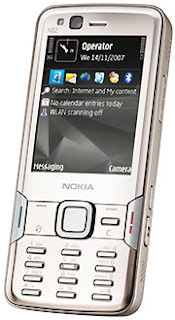
If you compare the N82 to the N95, you will find lots of similarities between the two phones. For instance, a 5-megapixel camera with autofocus and Carl Zeiss lens and built-in GPS with A-GPS support. Then there’s also the 3.5mm audio jack, HSDPA and onboard 802.11b/g wireless LAN. So the big question here is, what sets this latest N-series camera-phone apart from the popular N95? We recently had a sneak preview of the phone before the launch and here’s what we found out.
Upside
Clearly, the most obvious difference between the N82 and N95 is the form factor. The N82 adopts a candy-bar design, much like the N73, though admittedly it didn’t feel as solid as the latter. The N95, as we all know, uses a two-way slider which is shorter than the N82 but is also somewhat more bulky and heavier.
The most distinct feature in the N82 is the addition of a Xenon flash unit, much like the ones we’ve seen on the Sony Ericsson handsets such as the K800i and K850i. Generally, cameras with flash units take better pictures especially in poor light condition, compared to those with LED illuminators which are more like torchlights. An orientation sensor using built-in accelerometers has also been added for quick toggling between portrait and landscape modes.
Another thing we noticed about the N82 is its higher 1,050mAh capacity battery. As a result, the rated talktimes and standby times are also higher than the N95 which has a 950mAh cell. USB connectivity on the N82 is via microUSB while the N95 comes with a miniUSB port.
Otherwise, the N82 has pretty much everything you can find on the N95, most notably the VGA video capture (at 30fps) with video stabilisation, TV-out, A2DP Bluetooth stereo, 16-million-colour display and FM radio (with Visual Radio). Like the N95, the N82’s onboard GPS is also supported by A-GPS and Nokia Maps applications. The N82 comes with just 100MB of onboard memory compared with 160MB on the N95, but it does come bundled with a 2GB microSD card.
Downside
One of the tradeoffs for the N82’s candy bar is its smaller 2.4-inch QVGA display which will now make it even harder to surf the Web or use for GPS directions. (The N95 sports a 2.6-inch screen.) Also, the prototype unit of the N82 we saw came in a light silver tone which is a good neutral colour for most mobile users, but we felt it made the phone a tad too plasticky. Hopefully, we will see an improvement in this aspect for the commercial unit. Or perhaps an 8GB version of N82 in black?
With the N82, there are no dedicated buttons for multimedia playback. Some users may also find the number keys a tad too tiny to press.
Outlook
Like the N95, the N82 is a powerful handset that will certainly appeal to those who want a full-featured mobile phone. In particular, the addition of the Xenon flash will put the handset on par with the Sony Ericsson K850i for camera-phone fanatics. The lack of unique features on the N82 is, however, unlikely to make it compelling enough for N95 users to upgrade.
According to Nokia, the N82 is expected to be available in selected Asian markets within the next few weeks.







Leave a Reply